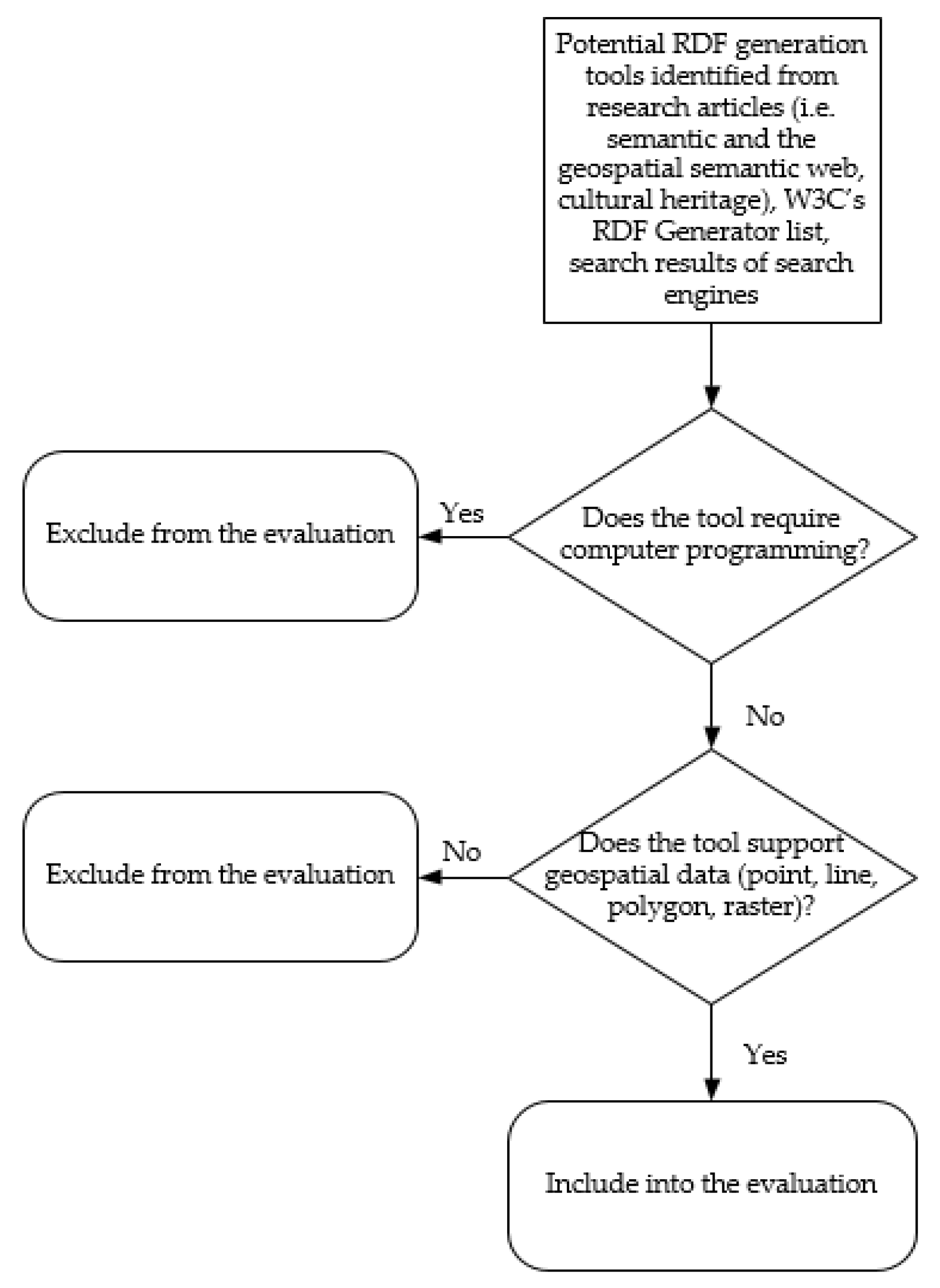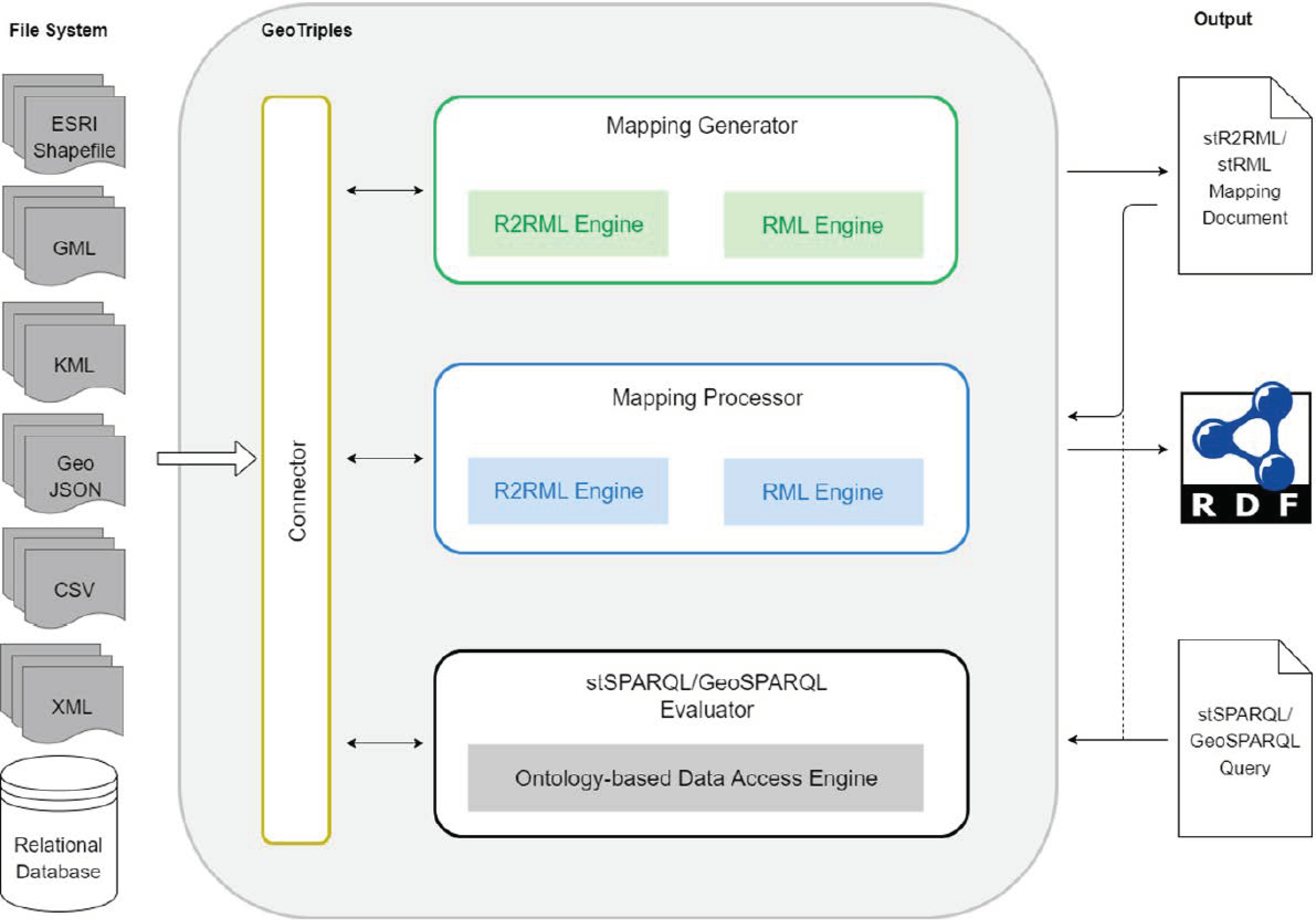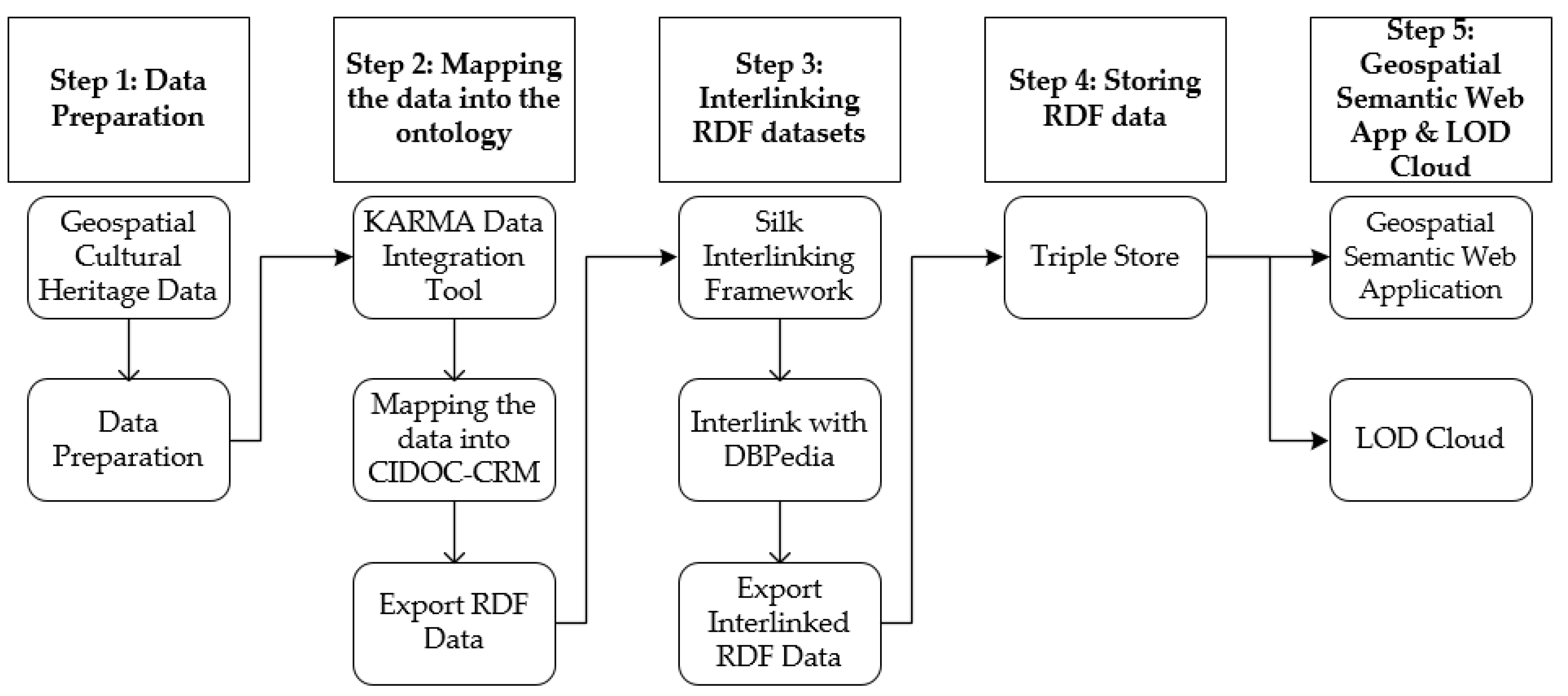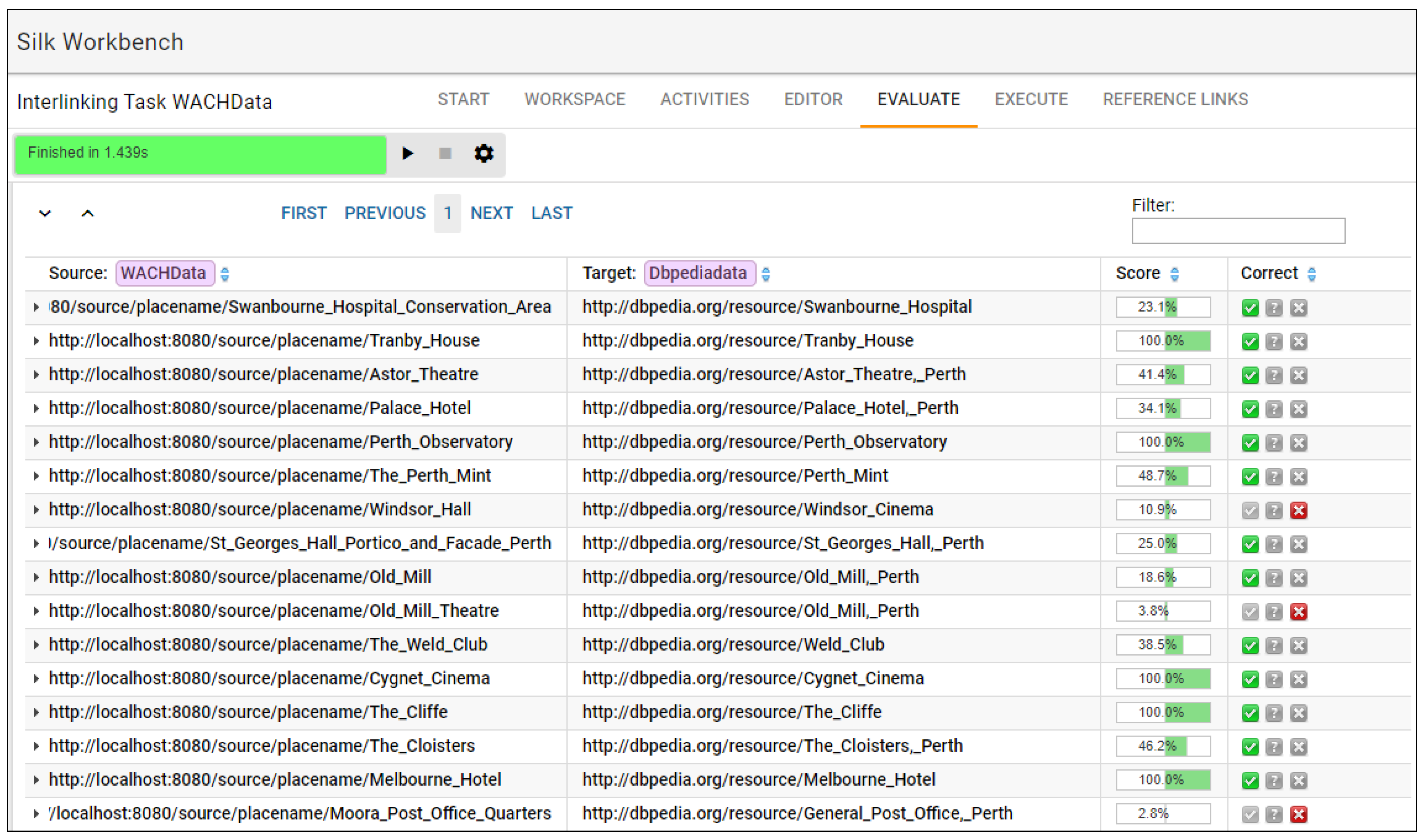A Comparative Evaluation of Geospatial Semantic Web Frameworks for Cultural Heritage
Abstract
1. Introduction
2. Background Literature
2.1. Semantic Web and the Geospatial Semantic Web
2.2. The Geospatial Semantic Web and Cultural Heritage
3. Methodology
3.1. Criteria for Selecting RDF Generation Tools
3.2. Criteria for Selecting RDF Linking Frameworks
4. Comparative Evaluation
4.1. A Comparative Evaluation of RDF Data Generation Tools
4.2. A Comparative Evaluation of RDF Linking Frameworks
5. Methodology for Producing Linked Geospatial Cultural Heritage Data
6. Discussion
7. Conclusions
Author Contributions
Funding
Conflicts of Interest
References
- Campanaro, D.M.; Landeschi, G.; Dell’unto, N.; Leander Touati, A.-M. 3D GIS for cultural heritage restoration: A ‘white box’ workflow. J. Cult. Herit. 2016, 18, 321–332. [Google Scholar] [CrossRef]
- Soler, F.; Melero, F.J.; Luzón, M.V. A complete 3D information system for cultural heritage documentation. J. Cult. Herit. 2017, 23, 49–57. [Google Scholar] [CrossRef]
- Bizer, C.; Heath, T.; Berners-Lee, T. Linked data-the story so far. Int. J. Semant. Web Inf. Syst. 2009, 5, 1–22. [Google Scholar] [CrossRef]
- Egenhofer, M.J. Toward the semantic geospatial web. In Proceedings of the 10th ACM international symposium on Advances in geographic information systems, McLean, VA, USA, 8–9 November 2002; pp. 1–4. [Google Scholar]
- Zhang, C.; Zhao, T.; Li, W. Conceptual Frameworks of Geospatial Semantic Web. In Geospatial Semantic Web; Springer: Cham, Switzerland, 2015; pp. 35–56. [Google Scholar]
- Hiebel, G.; Doerr, M.; Eide, Ø. CRMgeo: A spatiotemporal extension of CIDOC-CRM. Int. J. Digit. Libr. 2017, 18, 271–279. [Google Scholar] [CrossRef]
- Hyvönen, E.; Heino, E.; Leskinen, P.; Ikkala, E.; Koho, M.; Tamper, M.; Tuominen, J.; Mäkelä, E. WarSampo Data Service and Semantic Portal for Publishing Linked Open Data About the Second World War History. In Proceedings of the 13th International Conference, ESWC: European Semantic Web Conference, Heraklion, Greece, 29 May–2 June 2016; pp. 758–773. [Google Scholar]
- Schmachtenberg, M.; Bizer, C.; Paulheim, H. Adoption of the linked data best practices in different topical domains. In Proceedings of the 13th International Semantic Web Conference, Riva del Garda, Italy, 19–23 October 2014; pp. 245–260. [Google Scholar]
- Trizio, I.; Savini, F.; Giannangeli, A. Integration of three-dimensional digital models and 3d gis: The documentation of the medieval burials of amiternum (l’aquila, Italy). Int. Arch. Photogramm. 2018, 42, 1121–1128. [Google Scholar] [CrossRef]
- Lezzerini, M.; Antonelli, F.; Columbu, S.; Gadducci, R.; Marradi, A.; Miriello, D.; Parodi, L.; Secchiari, L.; Lazzeri, A. Cultural heritage documentation and conservation: Three-dimensional (3D) laser scanning and Geographical Information System (GIS) techniques for thematic mapping of facade stonework of St. Nicholas Church (Pisa, Italy). Int. J. Archit. Herit. 2016, 10, 9–19. [Google Scholar] [CrossRef]
- Elfadaly, A.; Lasaponara, R.; Murgante, B.; Qelichi, M.M. Cultural heritage management using analysis of satellite images and advanced GIS techniques at East Luxor, Egypt and Kangavar, Iran (a comparison case study). In Proceedings of the International Conference on Computational Science and Its Applications, Trieste, Italy, 3–6 July 2017; pp. 152–168. [Google Scholar]
- Gruber, T.R. A translation approach to portable ontology specifications. Knowl. Acquis. 1993, 5, 199–220. [Google Scholar] [CrossRef]
- Battle, R.; Kolas, D. Geosparql: Enabling a geospatial semantic web. Semant. Web J. 2011, 3, 355–370. [Google Scholar] [CrossRef]
- GeoSPARQL—A Geographic Query Language for RDF Data. Available online: https://www.ogc.org/standards/geosparql (accessed on 8 June 2020).
- CIDOC CRM. Available online: http://www.cidoc-crm.org/Version/version-5.0.4 (accessed on 8 June 2020).
- Simon, R.; Barker, E.; Isaksen, L. Exploring Pelagios: A visual browser for geo-tagged datasets. In Proceedings of the International Workshop on Supporting Users’ Exploration of Digital Libraries, Paphos, Cyprus, 23–27 September 2012. [Google Scholar]
- Isaksen, L.; Simon, R.; Barker, E.T.; de Soto Cañamares, P. Pelagios and the emerging graph of ancient world data. In Proceedings of the 2014 ACM Conference on Web Science, Bloomington, IN, USA, 23–26 June 2014; pp. 197–201. [Google Scholar]
- Nentwig, M.; Hartung, M.; Ngonga Ngomo, A.-C.; Rahm, E. A survey of current link discovery frameworks. Semant. Web 2017, 8, 419–436. [Google Scholar] [CrossRef]
- Knoblock, C.A.; Szekely, P.; Ambite, J.L.; Goel, A.; Gupta, S.; Lerman, K.; Muslea, M.; Taheriyan, M.; Mallick, P. Semi-automatically mapping structured sources into the semantic web. In Proceedings of the 9th Extended Semantic Web Conference, Heraklion, Greece, 27–31 May 2012; pp. 375–390. [Google Scholar]
- Kyzirakos, K.; Savva, D.; Vlachopoulos, I.; Vasileiou, A.; Karalis, N.; Koubarakis, M.; Manegold, S. GeoTriples: Transforming geospatial data into RDF graphs using R2RML and RML mappings. J. Web Semant. 2018, 52, 16–32. [Google Scholar] [CrossRef]
- Bereta, K.; Xiao, G.; Koubarakis, M. Answering Geosparql Queries over Relational Data. Int. Arch. Photogramm. Remote. Sens. Spat. Inf. Sci. 2017, 42, 43–50. [Google Scholar] [CrossRef]
- Patroumpas, K.; Alexakis, M.; Giannopoulos, G.; Athanasiou, S. TripleGeo: An ETL Tool for Transforming Geospatial Data into RDF Triples. In Proceedings of the EDBT/ICDT Workshops, Athens, Greece, 28 March 2014; pp. 275–278. [Google Scholar]
- Gali, N.; Mariescu-Istodor, R.; Fränti, P. Similarity measures for title matching. In Proceedings of the 23rd International Conference on Pattern Recognition (ICPR), Cancun, Mexico, 4–8 December 2016; pp. 1548–1553. [Google Scholar]
- Nishanbaev, I.; Champion, E.; McMeekin, D.A. A Survey of Geospatial Semantic Web for Cultural Heritage. Heritage 2019, 2, 1471–1498. [Google Scholar] [CrossRef]
| 1 | https://www.w3.org/TR/swbp-skos-core-spec/ (last accessed on 8 June 2020) |
| 2 | https://github.com/RDFLib/rdflib (last accessed on 8 June 2020) |
| 3 | https://pypi.org/project/ontospy/ (last accessed on 8 June 2020) |
| 4 | https://www.w3.org/TR/sparql11-query/ (last accessed on 8 June 2020) |
| 5 | https://www.w3.org/standards/semanticweb/ (last accessed on 8 June 2020) |
| 6 | https://www.ogc.org/ (last accessed on 8 June 2020) |
| 7 | http://www.strabon.di.uoa.gr/ (last accessed on 8 June 2020) |
| 8 | https://github.com/SemWebCentral/parliament (last accessed on 8 June 2020) |
| 9 | https://jena.apache.org/ (last accessed on 8 June 2020) |
| 10 | https://omeka.org/s/ (last accessed on 8 June 2020) |
| 11 | https://www.getty.edu/research/tools/vocabularies/tgn/ (last accessed on 8 June 2020) |
| 12 | https://www.w3.org/2001/sw/wiki/Category:RDF_Generator (last accessed on 8 June 2020) |
| 13 | https://www.w3.org/TR/owl-ref/#sameAs-def (last accessed on 8 June 2020) |
| 14 | http://ri-www.nii.ac.jp/SLINT/index.html (last accessed on 8 June 2020) |
| 15 | https://github.com/samuraraujo/SERIMI-RDF-Interlinking (last accessed on 8 June 2020) |
| 16 | https://code.google.com/archive/p/knofuss/downloads (last accessed on 8 June 2020) |
| 17 | https://usc-isi-i2.github.io/karma/ (last accessed on 8 June 2020) |
| 18 | http://www.cidoc-crm.org/Version/version-5.0.4 (last accessed on 8 June 2020) |
| 19 | http://ontop-spatial.di.uoa.gr/ (last accessed on 8 June 2020) |
| 20 | Reprinted from Journal of Web Semantics, Volumes 52–53, Kyzirakos et al, GeoTriples: Transforming geospatial data into RDF graphs using R2RML and RML mappings, Pages 16–32, Copyright 2020, with permission from Elsevier. |
| 21 | https://github.com/boricles/geometry2rdf/tree/master/Geometry2RDF (last accessed on 8 June 2020) |
| 22 | https://lod-cloud.net/ (last accessed on 8 June 2020) |
| 23 | https://catalogue.data.wa.gov.au/dataset/heritage-council-wa-state-register (last accessed on 8 June 2020) |








| Karma Data Integration Tool | GeoTriples | TripleGeo | OpenRefine Version 3.3 with an RDF Refine Extension | |
|---|---|---|---|---|
| Developed by | Center on Knowledge Graphs in Information Sciences Institute, the University of Southern California | EU Projects LEO and Melodies, National and Kapodistrian University of Athens | EU Project GeoKnow, the Athena Research Center | Freebase, then Google, now open source community |
| Supported Input File Formats and Types |
|
|
|
|
| Supported Output File Formats | RDF—Turtle syntax, JSON-LD | RDF—N-Triples syntax | RDF/XML, N-Triples, N3, Turtle | RDF/XML, Turtle |
| Built-in GeoSPARQL ontology compatible export option | No | Yes | Yes | No |
| Ontology import option | Yes | No (a user needs to edit the R2RML/RML mapping document to achieve that) | No (Supports exporting according to GeoSPARQL ontology, WGS84 RDF Geoposition Vocabulary and the Virtuoso RDF Vocabulary) | Yes |
| Origin | Karma is written in a Java programming language | D2RQ Engine (http://d2rq.org/) | Geometry2RDF (https://github.com/boricles/geometry2rdf/tree/master/Geometry2RDF) | OpenRefine is written in a Java programming language |
| Licence | Apache Licence 2.0 | Apache Licence 2.0 | GPL-3.0 | BSD 3-Clause “New” or “Revised” Licence |
| Source Code | https://github.com/usc-isi-i2/Web-Karma | https://github.com/LinkedEOData/GeoTriples | https://github.com/GeoKnow/TripleGeo | https://github.com/OpenRefine/OpenRefine |
| Official Website | https://usc-isi-i2.github.io/karma/ | http://geotriples.di.uoa.gr/ | http://geoknow.eu/Project.html | https://openrefine.org/ |
| Other | Supports importing and exporting R2RML models | Built-in support for the geospatial ontology stSPARQL | Built-in support for the geospatial ontologies WGS84 RDF Geoposition Vocabulary and Virtuoso RDF Vocabulary for point features | Offers reconciliation/linking two RDF datasets based on a SPARQL endpoint, RDF file, and Apache Standbol’s Entity Hub |
| LIMES Version 1.7.1 | Silk Version 3.0.0 | OpenRefine Version 3.3 with RDF Refine Extension | |
|---|---|---|---|
| Developed by | Agile Knowledge Engineering and Semantic Web (AKSW), Leipzig University | University of Mannheim | Freebase, then Google, now open source community |
| Supported data input formats |
|
|
|
| Supported output formats | Turtle (TTL) N-Triples (N3) Tab Separated Values (TAB) Comma Separated Values (CSV) | N-Triples (N3) Alignment (http://alignapi.gforge.inria.fr/format.html) | RDF/XML Turtle (TTL) |
| Matching technique/measures | String Vector Space Point-set Topological Temporal Resource-set Edge-counting semantic | Asian Character-based Equality Numeric Token-based | String |
| Licence | Gnu Affero General Public Licence | Apache Licence, Version 2 | BSD 3-Clause “New” or “Revised” Licence |
| Source Code | https://github.com/dice-group/LIMES | https://github.com/silk-framework/silk/releases | https://github.com/OpenRefine/OpenRefine |
| Official Website | http://aksw.org/Projects/LIMES.html | http://silkframework.org/ | https://openrefine.org/ |
| Required software to execute the framework | Java SDK 12 (or later) and Maven 3.6.2 (or later) | Java JDK 8 Simple Build Tool (sbt) Yarn dependency management tool | None |
| Pre-processing functions | Yes Supports various types of pre-processing functions such as converting a string to lowercase, uppercase, replacing a string character, etc. | Yes Supports many types of pre-processing functions such as string to lowercase, removing whitespaces in strings, replacing a string character, format a number according to a user-defined pattern, etc. | Yes Supports many types of pre-processing functions such as replacing a string character, transforming strings to uppercase, lowercase, etc. |
© 2020 by the authors. Licensee MDPI, Basel, Switzerland. This article is an open access article distributed under the terms and conditions of the Creative Commons Attribution (CC BY) license (http://creativecommons.org/licenses/by/4.0/).
Share and Cite
Nishanbaev, I.; Champion, E.; McMeekin, D.A. A Comparative Evaluation of Geospatial Semantic Web Frameworks for Cultural Heritage. Heritage 2020, 3, 875-890. https://doi.org/10.3390/heritage3030048
Nishanbaev I, Champion E, McMeekin DA. A Comparative Evaluation of Geospatial Semantic Web Frameworks for Cultural Heritage. Heritage. 2020; 3(3):875-890. https://doi.org/10.3390/heritage3030048
Chicago/Turabian StyleNishanbaev, Ikrom, Erik Champion, and David A. McMeekin. 2020. "A Comparative Evaluation of Geospatial Semantic Web Frameworks for Cultural Heritage" Heritage 3, no. 3: 875-890. https://doi.org/10.3390/heritage3030048
APA StyleNishanbaev, I., Champion, E., & McMeekin, D. A. (2020). A Comparative Evaluation of Geospatial Semantic Web Frameworks for Cultural Heritage. Heritage, 3(3), 875-890. https://doi.org/10.3390/heritage3030048





